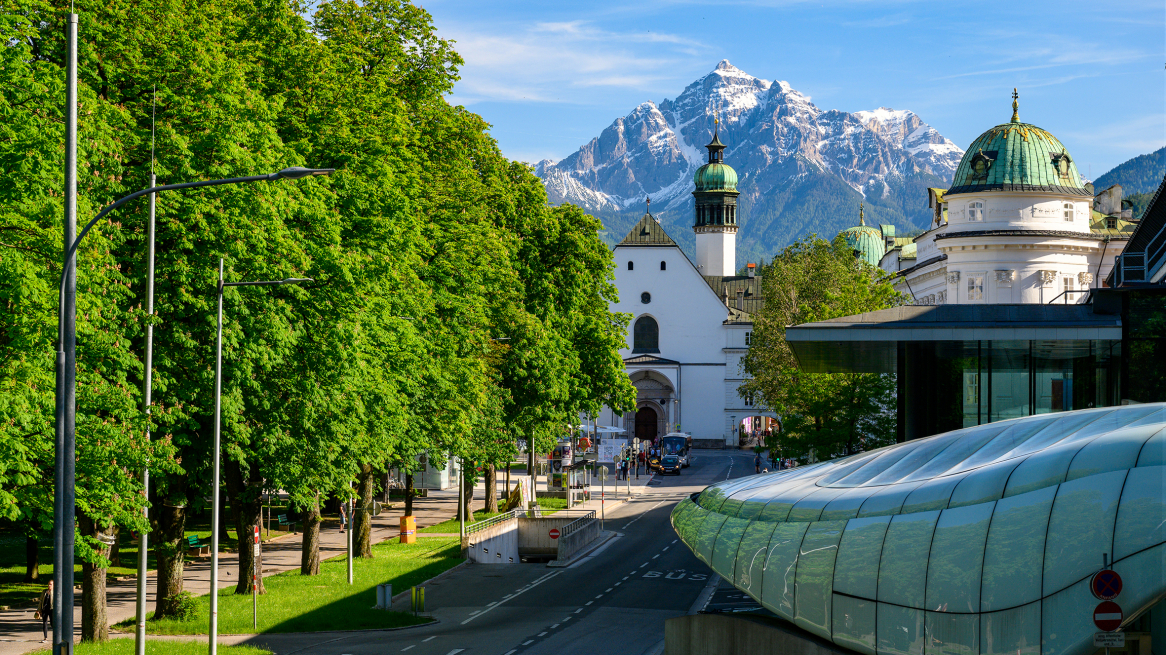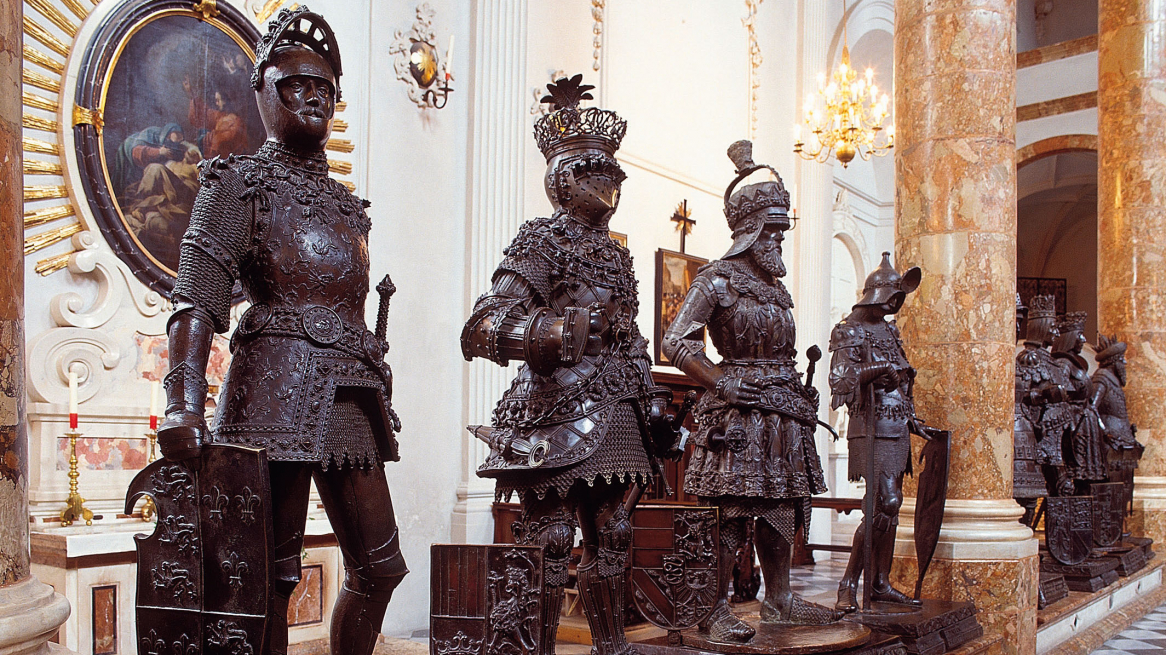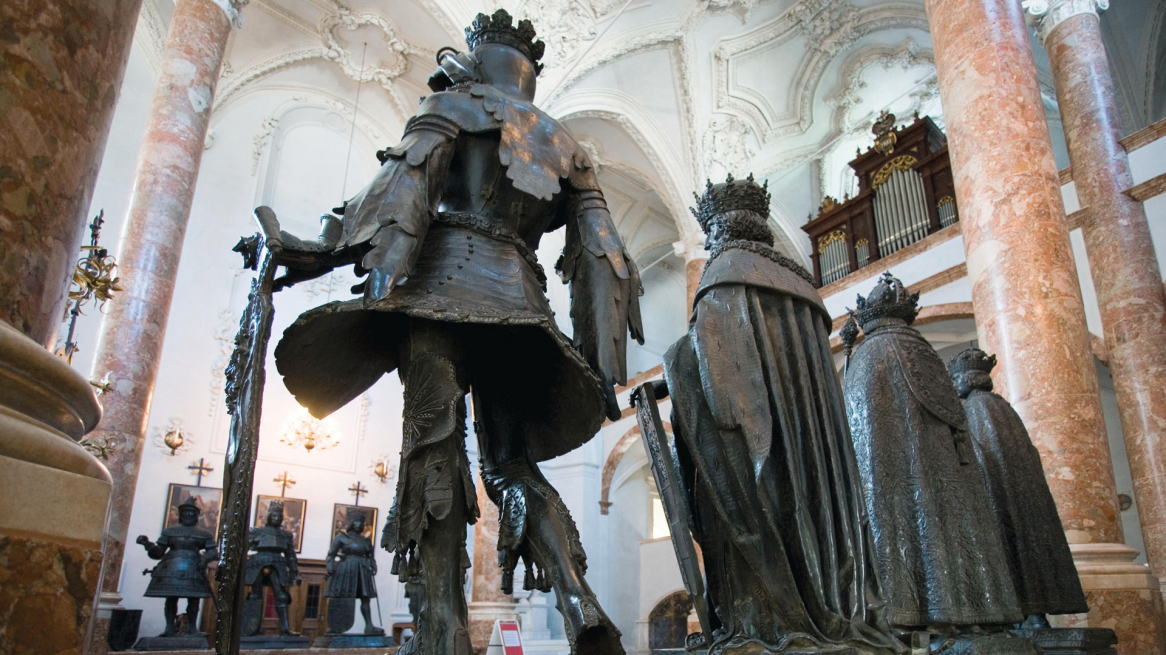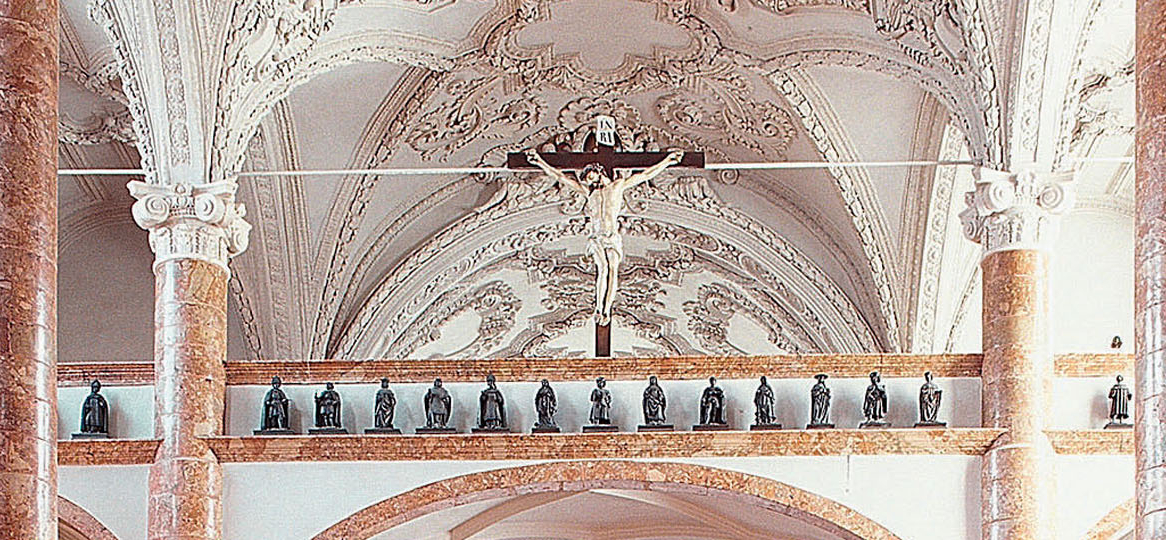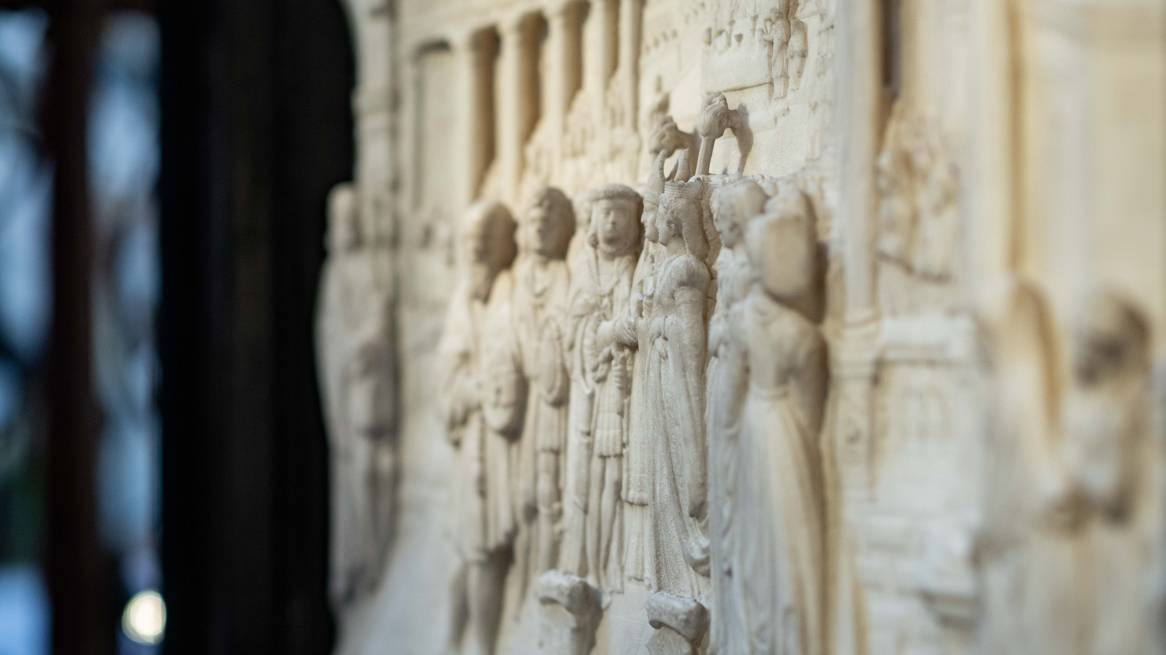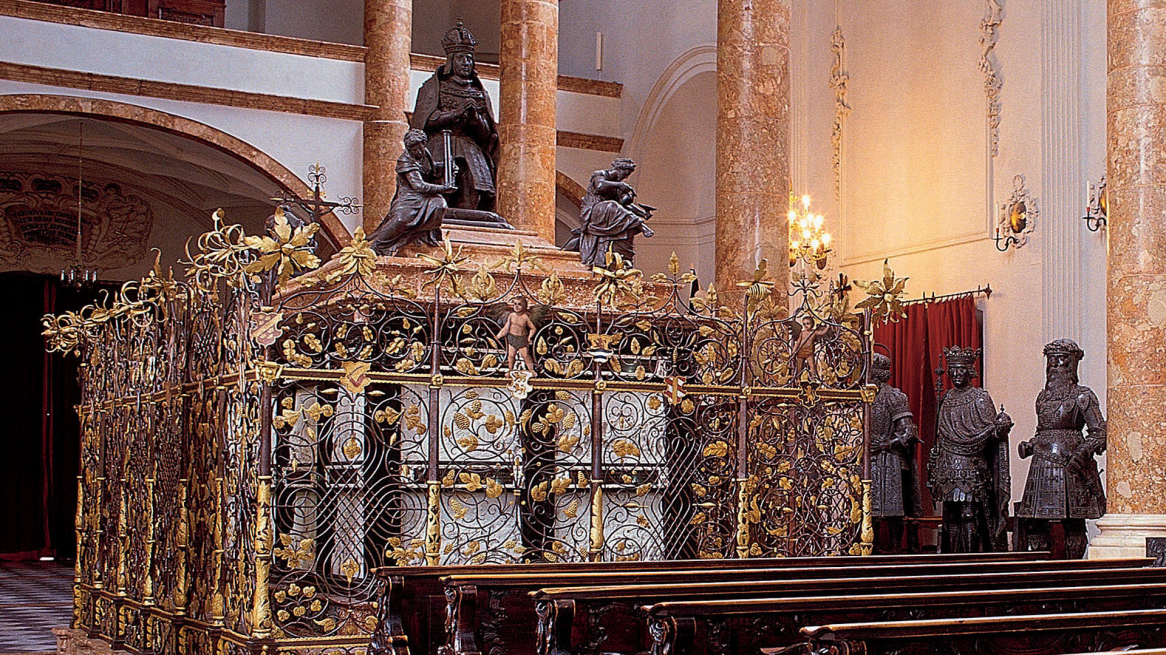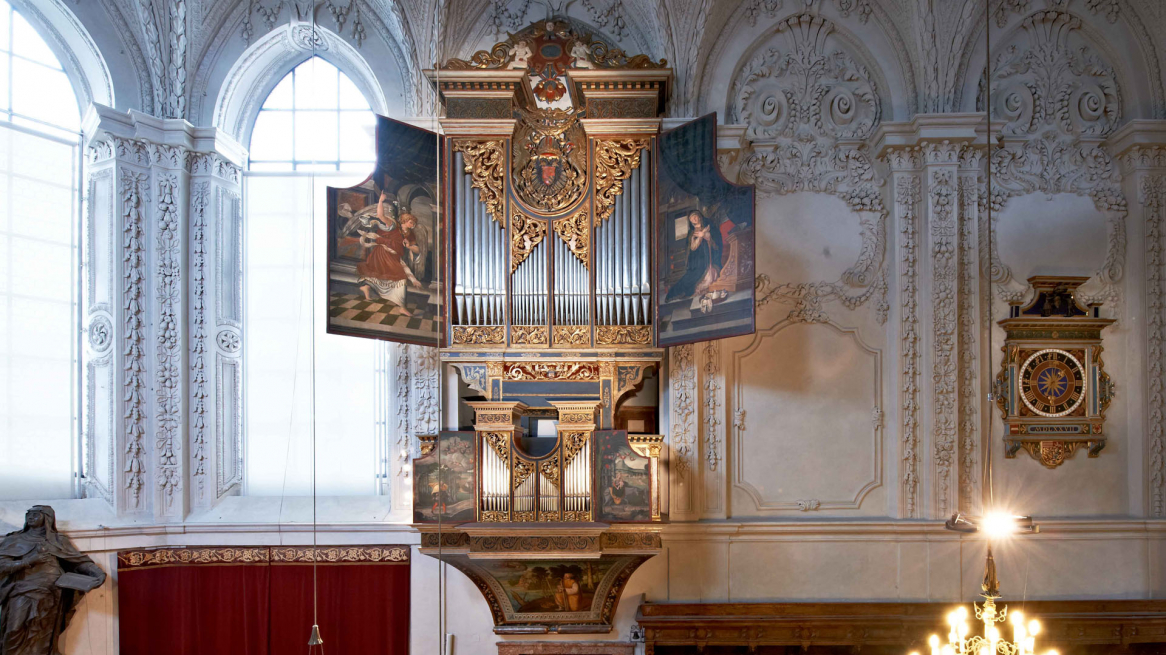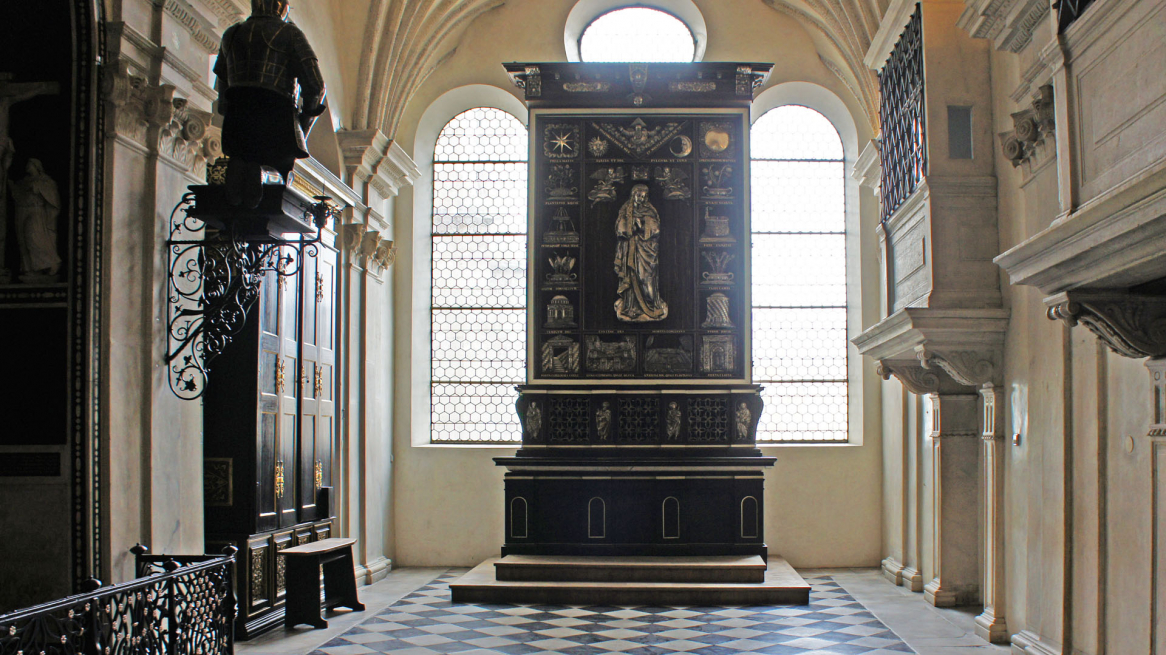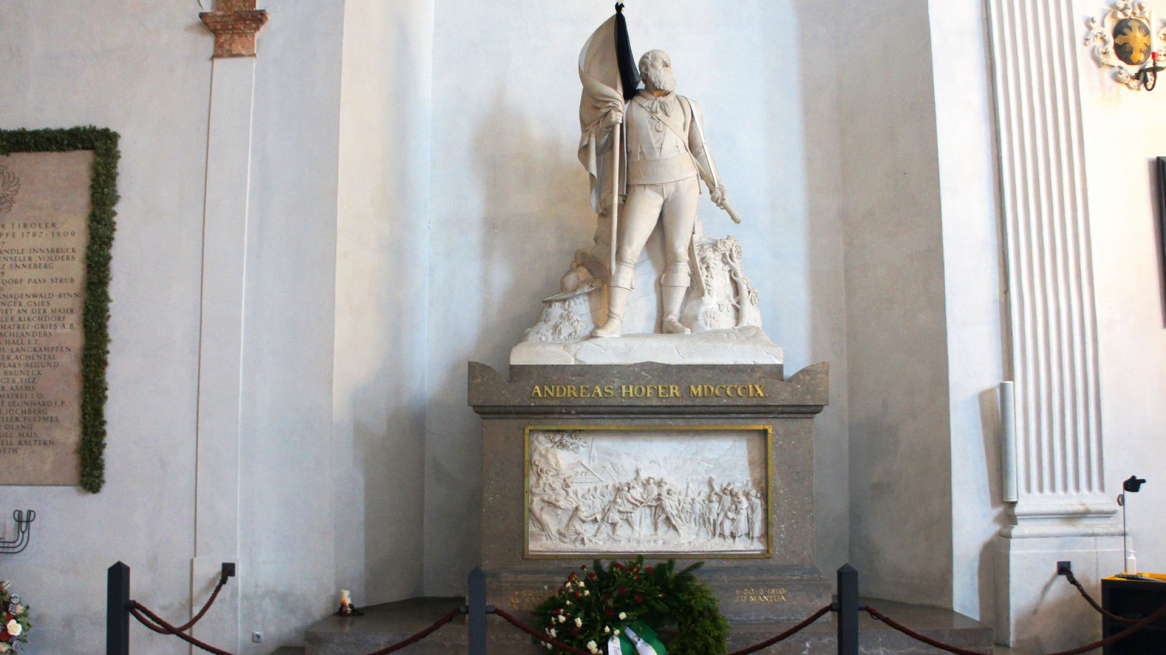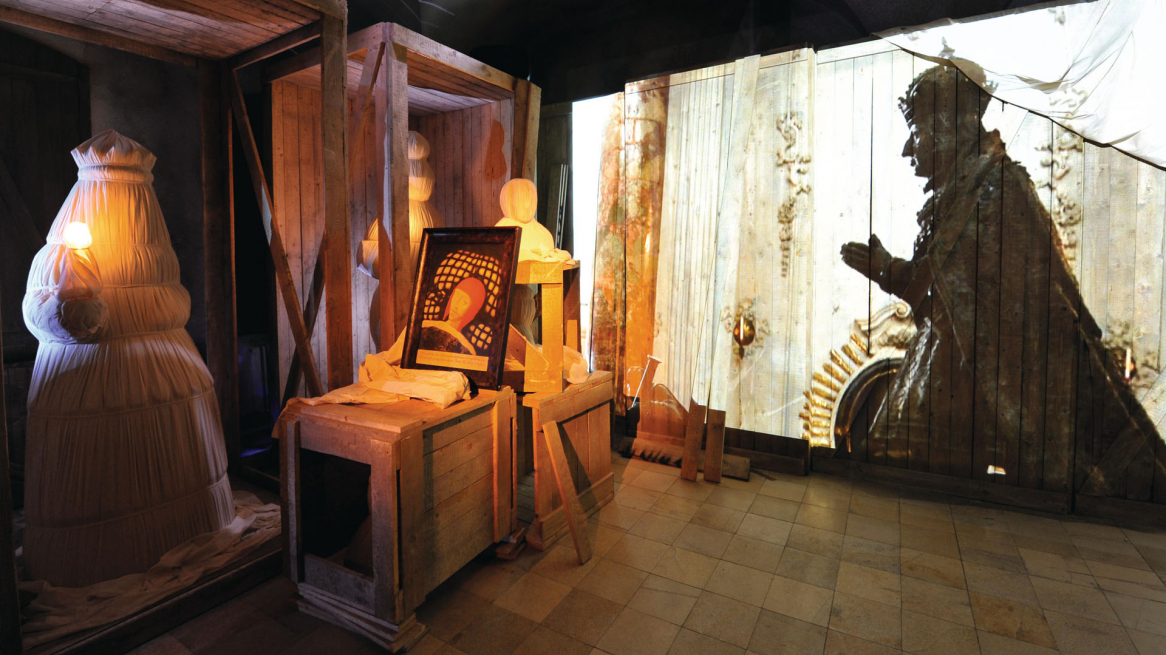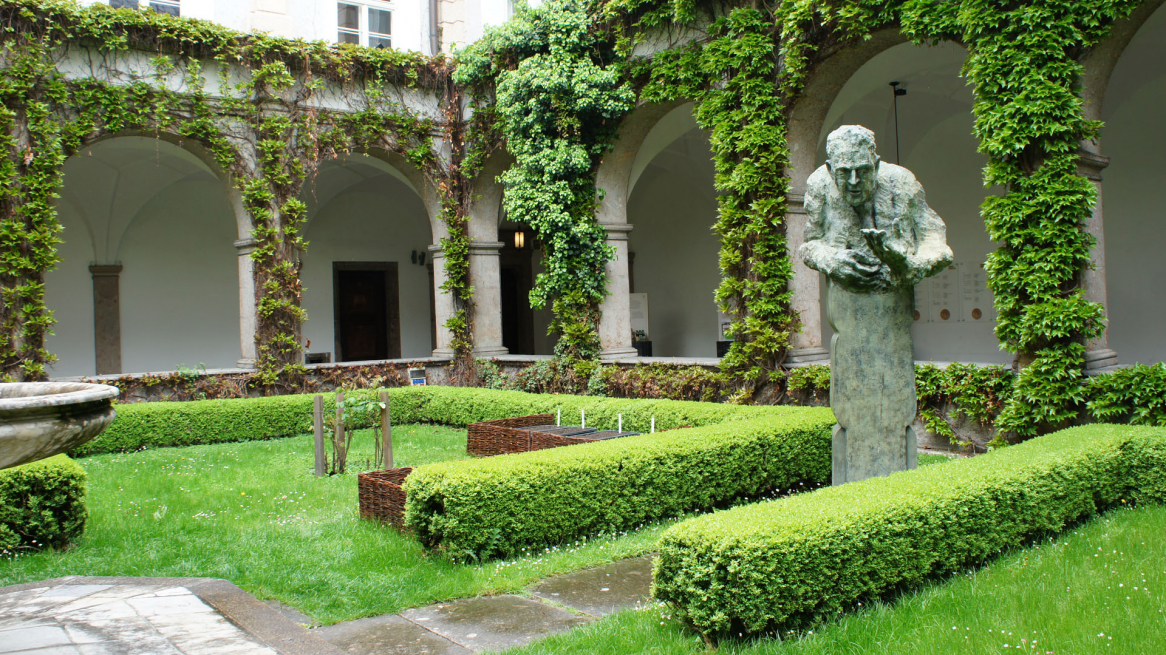
It is inconspicuous and simple from the outside, but inside it is full of stories, monuments and treasures: the Court Church in Innsbruck. The church not only houses Tyrol's most important art monument, but also a rare Renaissance organ and important tombs.
As a city guide, I love to entertain and inspire people with stories Innsbruck offers many unique places for special stories. Like all my colleagues, I have my absolute favorite places. The Hofkirche ranks high on the list.
The storytelling material here is almost limitless and includes several centuries of history as well as powerful rulers, brave fighters, magnificent craftsmanship, perfectly formed art as well as romance, music, the heroic and the absurd.
View of the Hofkirche with Hofgarten on the left and Hofburg on the right (© Tiroler Landesmuseen/Wolfgang Lackner)
The Tomb Monument of Emperor Maximilian I.
Imperial vision
In the beginning there was an idea of Emperor Maximilian I(1459-1519). The famous "last knight" and important ruler over the Habsburg Empire burned himself into the history books with his politics and his war campaigns as well as with his monuments.
Maximilian considered early on what his tomb should look like. He had a concrete and not exactly modest vision: his tomb, the tomb of a Roman-German emperor, was to consist of an elaborate high to mb flanked by a wake of larger-than-life figures. In addition, statuettes of the patron saints of the House of Habsburg and busts of Roman emperors were to complete the whole.
For eternity
To realize this idea, the emperor enlisted the best artists of the time. work on this project began in 1502 and did not end until an incredible 82 years (!) later. The casting of the bronze figures began in Innsbruck during Maximilian's lifetime. The difficult (and incidentally unhealthy) casting of such complex figures could only be undertaken by exceptionally good workshops, and such workshops existed in Innsbruck.
Maximilian, however, did not decide on one thing, namely where the tomb should be placed. Only on his deathbed did he express the wish to be buried in the city of his birth, Wiener Neustadt. He died at the age of 60 in the castle of Wels.
As a result, a rather absurd situation arose. The emperor was buried, according to his wish, in the church of the Wiener Neustadt castle . But his monument was far from being finished. It was not until many years later that it found its place in the specially built court church in Innsbruck. To this day, the funerary monument of Emperor Maximilian I remains empty. Nevertheless, it is the most valuable treasure in Tyrol in terms of art history .
Idea and reality
Maximilian's idea for the tomb was recorded in the sketches of his court painters. Thanks to this parchment scroll, which is in the trove of Ambras Castle we know exactly how it was planned. But the scope was beyond any time and financial limits.
The bronze statues
The wake was designed with 40 larger-than-life, gilded bronze figures. Of these, 28 figures could be realized, but all without gilding. Most of the figures come from Maximilian's ancestors, but there are also historical heroes among them. Each of the figures tells its own story. At the same time, the artistic design and the richness of detail are breathtaking and it is worth looking at the statues from the back as well. The details of the robes, armor or hairstyles are impressive.
A back can also delight! The bronze figures are worth seeing all around. (© Innsbruck Tourism/Roger Rovira)
The particular historical fidelity is remarkable in some bronze sculptures, such as King Rudolf I. , whose face was modeled on his death mask. The most famous figures are King Arthur of England, Gothic King Theoderic as well as Count Albrecht IV after the designs of Albrecht Dürer. These statues of the High Renaissance are striking for their elegant movements. In any case, my personal favorites are the figures of Emperor Frederick III, Maximilian's father, and of Mary of Burgundy, Maximilian's first wife. I find Frederick's heavy coronation mantle and striking face with crown just as exciting as Mary's beauty and richly decorated gown including hat.
The black figures, by the way, are colloquially referred to as "Schwarze Mander," or black men. This is not quite accurate, since eight women are also included.
Artists - designers: Jörg Kölderer, Ulrich Tiefenbrunn, Jörg Polhaimer the Elder, Christoph Amberger, Albrecht Dürer, Artusmeister; Artists - carvers: Leonhard Magt, Hans Leinberger, Veit Stoß, Veit Arnberger; Artists - casters: Gilg Sesselschreiber (also designer), Gregor and Peter Löffler, Stefan Godl, Peter Vischer the Elder and the Younger.
initially,100 statuettes of the Habsburg clansaints, the so-called "Sankti", were planned, but today 23 are on display in the gallery of the Hofkirche.
Artists: Jörg Kölderer, Stefan Godl, Leonhard Magt
The Imperial Busts
Busts of Roman emperors were also part of the concept. After all, Maximilian saw himself as the successor to the Roman Caesars. Although the 34 busts never made it into the court church, 21 of them have been preserved and are now in the Antiquarium of Ambras Castle.
Artists: Konrad Peutinger, Jörg Muskat
The high grave
The depth effect of the reliefs on the cenotaph is imposing. (© Tyrolean Provincial Museums/Gerhard Berger)
A cenotaph refers to an empty tomb. It was not part of the original design and was implemented under Emperor Ferdinand I. , Maximilian's grandson. The mighty high tomb in the center of the Court Church is adorned by 24 marble reliefs. The reliefs depict important stages in Emperor Maximilian's life, such as his marriage to Mary of Burgundy or the siege of Kufstein. These are true masterpieces of the Flemish High Renaissance, characterized by an impressive depth effect and a great wealth of detail. In addition, the tomb is surrounded and decorated by an elaborate wrought iron grille.
On the empty tomb, Emperor Maximilian I is shown in bronze in a kneeling and praying pose. Thus he is portrayed as the devout man he was throughout his life and as humble before God. His figure is also accompanied by the four cardinal virtues of justice, temperance, fortitude and wisdom. With the Maximilian statue, the funerary monument was finally completed in 1584 under Archduke Ferdinand II. the son of Ferdinand I, was completed.
Artists Cenotaph: Florian, Bernhard and Arnold Abel, Alexander Colin
Artists wrought iron grille: Jörg Schmidhammer, Paul Trabel
The Court Church
Finally, it is thanks to Emperor Ferdinand I(1503-1564) that the funerary monument of his grandfather Maximilian in Innsbruck can be seen. He decided that the project was completed with 28 of the 40 figures designed and that they were not gilded.
Since Maximilian's death, of course, there have been thoughts of bringing the bronze figures to Wiener Neustadt as an escort for the emperor's dead to his grave. But the church of the castle is on the second floor and so this idea failed because of the statics. The figures would have been much too heavy , after all the heaviest figure alone weighs about two tons.
Therefore, Ferdinand donated the court church and the Franciscan monastery in Innsbruck for the monument. The Renaissance church was built from 1553 to 1563, based on the model of the Holy Cross Church in Augsburg. The beautiful portal of the church is remarkable. Baroque stucco was later added to the interior.
The former monastery building is now the Tyrolean Folk Art Museum. The court church is now cared for by the Capuchin Order and masses are said daily.
Artists: Andrea Crivelli, Alessio and Hieronymus Longhi, Niclas Türing the Younger, Marx della Bolla
The Ebert organ
The sanctuary of the Hofkirche houses another treasure: the Ebert organ from 1558 is one of the oldest playable and also one of the most valuable organs in the world. The majority of the organ pipes are even still original. The Renaissance organ was built by Jörg Ebert from Ravensburg. The case made of pine wood has artistically designed wing doors that are opened during concerts.
In the organ competition for the Paul Hofhaimer Prize, participants play on historic organs in Innsbruck. Of course, the Ebert organ must not be missing! The Paul Hofhaimer Competition takes place every three years and the next time from September 2 to 8, 2022.
The Silver Chapel
Archduke Ferdinand II (1529-1595) had the Court Church extended with a chapel to the northwest. Through this chapel and another corridor the Hofkirche is connected with the Imperial Palace connected with it. The Silver Chapel became first the burial chapel for Ferdinand's civil wife Philippine Welser and finally for the archduke himself. The tombs in the wall niches were created by Alexander and Abraham Colin. In addition, the silver altar is worth seeing (and giving its name to). The reliefs, chased in silver, depict Mary and her symbols, a work by Anton Ort.
The Andreas Hofer Monument
Furthermore, an important tomb finds its place in the Court Church and tells a heroic story: In 1809, the Tyrolean freedom fighters confronted Napoleon's armies to liberate Tyrol. The French emperor had previously declared the Tyrol a part of the Kingdom of Bavaria. The Tyrolean fighters were the first in Europe to defeat Napoleon's army. After winning several battles at the Bergisel, however, the Tyroleans lost the decisive one and so their efforts were ultimately in vain.
Andreas Hofer (1767-1810), the leader of the Tyrolean freedom fights, was initially buried in Mantua after his execution. But 13 years later, a Tyrolean regiment of emperor hunters brought Hofer's mortal remains back to Tyrol.
And so the hero from Tyrol received a tomb donated by the emperor in the Hofkirche. The Hofer monument consists of a pedestal with a relief and a large statue. The almost three meter high Hofer figure made of marble from Lasa was crafted by Johann Schaller. The relief, a work by Josef Klieber in Carrara marble, shows the "Oath of Allegiance". Here, too, the work took longer than planned, and the monument was completed in 1837.
Visit to the Court Church
The multimedia show is the best way to get in the right mood for a visit to the Hofkirche. (© Innsbruck Tourism/Tyrolean Folk Art Museum)
The Hofkirche is run as a museum and is part of the Tyrolean Regional Museums. Access is via the entrance of the Tyrolean Folk Art Museum and not via the church portal. Before entering the church, there is a multimedia show to see, which tells Maximilian's life exciting. To get in the mood for the Hofkirche visit, I find this show perfect.
The church itself can be reached via the beautiful cloister of the former Franciscan monastery. Here you can admire another work of art: the Eduard Wallnöfer bust by Rudi Wach.
Information
Hofkirche: Universitätsstraße 2, 6020 Innsbruck, Tel.: +43 512 59489-510,
volkskunstmuseum@tiroler-landesmuseen.at, www.tiroler-landesmuseen.at
Regular opening hours: Mon - Sat 9:00 a.m. - 5:00 p.m.*, Sun & Holidays 12:30 p.m. - 5:00 p.m.*
(* lastadmission 4:30 p.m.)
Concerts and organ tours in the Hofkirche: dates
Admission included with Innsbruck Card
Services: weekdays: 8:00 a.m. (Capuchin); Sundays and Holidays: 9:00 a.m. (Capuchin), 11:00 a.m. (Capuchin) and 7:00 p.m. (German Order)
Rate this article
Show me the location on the map
A Tyrolean girl, graphic designer, blogger and tour guide with a variety of interests and a weakness for nice people, culture, starry night skies, one more beer and the mountains.
Similar articles
#sundowner #afterworkdrink #summerparty - looking for the perfect Insta photo? You can easily get one in Innsbruck,…
A shopping tour on foot or by bike in a rural 'supermarket'? You can do just…
Since the 1980s, Mair’s Beerengarten in Rietz has stood for regional quality and warm hospitality. What was…
Strolling through the market on a Saturday morning, chatting with the traders and farmers, just letting yourself…

